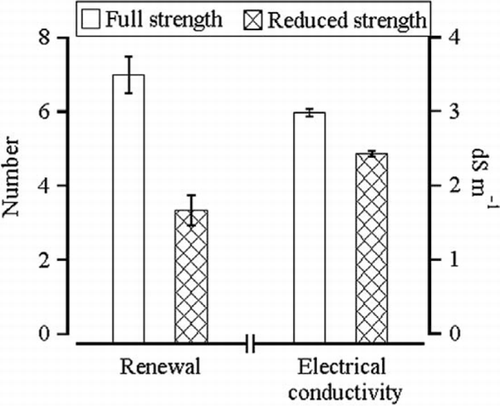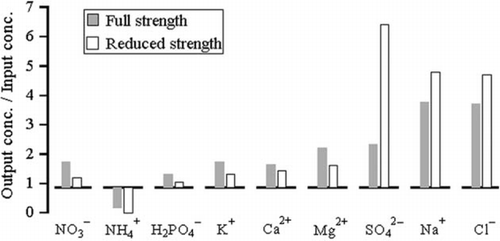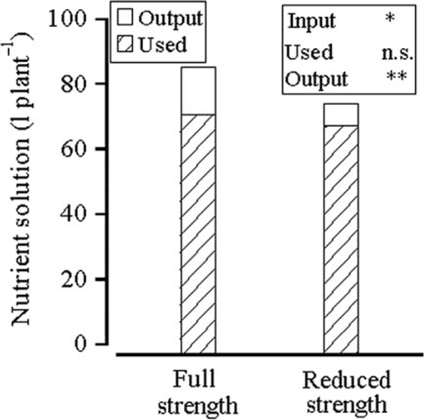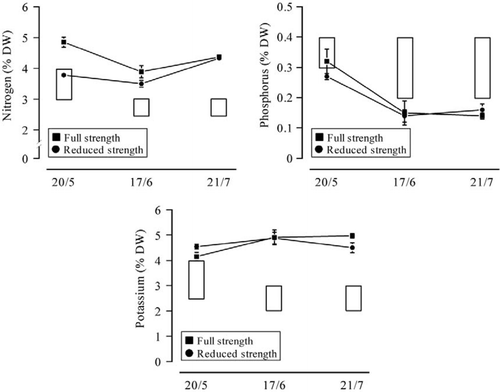Abstract
The aim of the experiment was to verify how the adoption of a reduced strength nutrient solution in a soilless closed system could influence the production and quality of pepper and improve the use efficiency of water and minerals. Two nutrient solutions characterized by the same ion ratio but macronutrient concentration equal to 100% or 60% were adopted. The total yield did not differ between the treatments; however the lower concentration of nutrients determined a significant reduction of incidence of unmarketable fruits (blossom-end rot) and thus a higher marketable production (+15%). Within the fruit quality characteristics the dry matter content and the titratable acidity were significantly higher adopting the full strength nutrient solution. Important differences were found when the agronomic water use efficiency was considered: the weight of marketable pepper produced per m3 of water input was about 32% higher using the reduced concentration treatment according to the lower volume of water released in the environment due to the lower renewal of recirculated nutrient solution. A similar pattern was observed for the use efficiency of the main nutrients. With reduced strength nutrient solution the amounts of nitrogen, phosphorus and potassium released per ton of marketable tomatoes were respectively 83%, 80% and 81% lower than the control. The use of a reduced strength nutrient solution in soilless closed system for pepper cultivation did not influence the total yield and improved the use efficiency of water and minerals. Moreover, the environmental impact of the system was drastically reduced.
Introduction
The use of a closed soilless cultivation system is necessary to reduce the high amount of water and nutrients released in the environment when an open system is adopted. In the closed systems, the nutrient solution (NS) drained from the growing medium is collected, blended with fresh NS, to restore the consumed NS by the plants, and recirculated for the subsequent irrigation. In greenhouse production areas characterized by a low technology profile, the recirculating NS is leaked and renewed with fresh NS when the electrical conductivity (EC) reaches a threshold value. Anyway, these systems increase the water and fertilizer use efficiency and reduce the pollution caused by the nutrient runoff (Voogt & Sonneveld, Citation1997; Van Os, Citation1999). However, a deeper knowledge of plant needs for water and nutrients is required for a suitable management of closed systems. In fact, water and nutrients should be supplied in accordance with plant uptake to avoid an increase or a depletion of nutrients in the recirculating NS and thus its frequent renewal, because of EC rising or nutrient deficiency. This could reduce the opportunity of a closed system to improve water and mineral use efficiency.
An accumulation of the main macronutrients and ions less used by the crop in the recirculating NS was found on tomato cultivated with a closed system in Mediterranean conditions using a fresh NS recommended for the Dutch greenhouse industry (Sonneveld & Straver, Citation1992), especially with high evapotranspiration demand typical of spring–summer season (Giuffrida et al., Citation2003). Even for Central European conditions, Kläring et al. (Citation1999) advised for tomato and pepper to adjust the NS concentration to levels lower that those recommended for the Dutch greenhouse industry, because of the influence of climatic conditions on nutrient uptake.
Pepper is a widespread vegetable crop in the Mediterranean area, due to its economic importance and nutritional properties. The NS usually used for pepper cultivation showed a nitrogen concentration that ranges from 12 to 14 mmol l−1 (Sonneveld & Straver, Citation1992; Navarro et al., Citation2002). However, Bar-Tal et al. (Citation2001) found for pepper cultivated in Mediterranean conditions an optimal nitrogen concentration that ranges between 8.0 and 9.4 mmol l−1, confirmed by Schon et al. (Citation1994). Asher and Edwards (Citation1983) demonstrated that plants may grow well even at lower concentrations of nutrients with respect to the ones generally used in soilless crops.
The aim of this research was to verify if and how the adoption of nutrient solution with reduced strength could improve the use efficiency of water and minerals and influence the production and quality of pepper cultivated in a Mediterranean climate with a closed soilless system.
Materials and methods
Location, plant material and growth conditions
The experiment was conducted in spring–summer 2009 in a 800 m2 un-heated polyethylene greenhouse, located at the Experimental Farm of Catania University, southern Italy (37.3° N, 15.0° E; 20 m a.s.l.). Seedlings of pepper (Capsicum annuum) hybrid F1 ‘Icaro’ were transplanted on 8 April at the third true-leaf stage, one for each pot (height 20 cm, width 19 cm) containing 5 litre of perlite (particle size 3–5 mm). The pots were placed in troughs with a distance of 33 cm between pots and 100 cm between troughs, creating a plant density of 3 plants m−2. Harvesting started in the first week of July and ended at the beginning of August.
Plants were grown under natural light conditions; ventilation was automatically provided when the air temperature exceeded 30 °C. The mean air temperature, the vapour pressure deficit and the global radiation inside the greenhouse during the experimental period were recorded on a data logger (CR10 X, Campbell Scientific). The mean air temperature was 23.1 °C, the mean vapour pressure deficit 1.5 kPa and the mean global radiation 11 MJ m−2.
Nutrient solution management
Two NS characterized by the same ion ratio, but with a macronutrient concentration equal to 100% (full strength; control) or 60% (reduced strength) were compared. The compositions of the used NS are given in .
Table I. Electrical conductivity (EC; dS m−1) and concentration of macronutrients a (mmol l−1) in the starting nutrient solutions used as experimental treatments.
A closed soilless cultivation system was adopted. The drainage reached directly the feeding tank where it was mixed with the new solution, added at each irrigation to reintegrate crop consumption. The pH of recirculating NS was continuously measured and adjusted to the pH of fresh NS (5.9) by adding sulphuric acid. The frequency of irrigation and the volume of the nutrient solution were scheduled on the basis of the water release curve of the substrate, vapour pressure deficit in the greenhouse and plant size. The vapour pressure deficit considered as the threshold for irrigation was quantified and periodically adjusted during the cultivation cycle, by gravimetrically measuring the plant consumption of the water contained in the substrate at intervals of −10 hPa to −25 hPa of matric potential. Additionally, the volume of irrigation water was adjusted to ensure a leaching fraction of about 80% to contain the increase of salt in the substrate (Kempkes & Stanghellini, Citation2003). Recirculating NS was leaked and replaced when the EC value increased of 2 dS m−1 from the initial one (2.5 dS m−1 for full strength NS and 2.0 dS m−1 for reduced strength).
Data collection and analysis
The epigeous biomass produced was determined by quantifying the portions removed by the harvesting and the plant at the end of the cycle. Biomass was dried in a forced air oven (70 °C) until steady weight was achieved.
The fruits were sorted into marketable and unmarketable (blossom-end rot, BER), counted and weighed. On 15 fruits per replicate the following parameters were determined: unit fresh weight, colour, pericarp thickness, titratable acidity, soluble solids and dry matter. The chromatic coordinates (L*, Chroma C* and hue angle h°) were measured as described by McGuire (Citation1992) by a tristimulus Minolta Chroma meter (model CR-200, Minolta Corp.). Titratable acidity was determined by titration at pH 8.2 with 0.01N NaOH solution and expressed as citric acid concentration (g l−1). Soluble solids (°Brix) were measured by a digital refractometer with automatic compensation of temperature (ATAGO).
The water balance was monitored by quantifying the water input provided with irrigation and the output released into the environment corresponding to the solution replacement. To calculate nutrient efficiency and plant nutritional status, the concentration of different minerals was evaluated. The reduced nitrogen was determined after mineralization with sulphuric acid, using the Kjeldahl method; the content of the main inorganic ions (NO3 −, H2PO4 −, K+, SO4 2−, Ca2 +, Mg2 +, Na+, Cl−) was determined by means of ionic chromatography (Dionex IC 25 Ion Chromatograph, 40 EG Eluent Generator) using an Ion Pac AS11-HC separation column for the anions and an Ion Pac CS-12A for the cations. The ion extraction was done according to the method described by Elia and Santamaria (Citation1995), using ultra-pure water for the anions.
The experiment was conducted as a randomized complete block design with four replicates; each experimental unit consisted of 12 plants. To determine the effects of nutrient solution strength, the analysis of variance (ANOVA) was performed with CoStat release 6.311 (CoHort Software).
Results and discussion
Yield and quality of pepper
The lower concentration of nutrients did not influence the total yield but enhanced the marketable production (+10%, as number of fruits, and +15%, as fruit weight, with respect to full strength treatment) because fewer fruits were affected by blossom-end rot (12.6% vs 21.5% for fruit number and 8.1 vs 16.8% for fruit weight, respectively for reduced and full strength NS) (). Our result is explained by the positive relation between EC nutrient solution and incidence of BER on pepper (Navarro et al., Citation2002; Savvas et al., Citation2007). The EC of full strength treatment was in fact 3 dS m−1, about 25% higher than that of the reduced strength treatment (). This finding is in agreement with de Kreij (Citation1999) who did not find a sodium specific effect on the incidence of BER for pepper fruits; in our experiment, the 100% NS treatment had the highest EC but the lowest Na+ concentration in the recirculating NS ().
Figure 1. Renewal number of recirculating nutrient solution and mean electrical conductivity (EC) during growing cycle in relation to nutrient solution concentration (full strength –100% and reduced strength –60%). The vertical bars represent standard error.

Figure 2. Ratio between ion concentration in the disposed nutrient solution (output conc.) and in the supplied nutrient solution (input conc.) in relation to nutrient solution concentration (full strength – 100% and reduced strength – 60%).

Table II. Plant fruit production in relation to nutrient solution concentration (full strength – 100% and reduced strength – 60%).
The different NS concentration determined slight effects on pepper fruit quality (). The fruits obtained from plants fed with full NS showed highest titratable acidity (+16%) and dry matter (+4.2%). These results seem to be more related with the nutrient concentration in the NS than its EC, since Rubio et al. (Citation2009) did not find any effect of moderate salinity on titratable acidity and soluble solids in pepper. Besides, in our research the positive effect of salinity found for titratable acidity, soluble solids and dry matter due to the shortage of water toward the fruits (Adams, Citation1991) is not confirmed. In fact, any difference was found between the treatments for unit fruit fresh weight and water plant uptake (, ). The pericarp thickness was not influenced by nutrient solution concentration; Navarro et al. (Citation2002) found a significant effect of sodium salinity when NS with higher EC level than ours was adopted.
Figure 3. Nutrient solution balance in relation to nutrient solution concentration (full strength –100% and reduced strength –60%). n.s.=not significant; *, ** and *** represent significance at 0.01 < p<0.05, 0.001 < p<0.01 and p<0.001.

Table III. Fruit quality characteristics a in relation to nutrient solution concentration (full strength – 100% and reduced strength – 60%).
Water and mineral balance
Concerning the balance of the NS, the input was about 20% less in the reduced strength compared with the full strength treatment (), as a consequence of the sharp decrease of water released in the environment (−70%). The output reduction is clearly related to the number of the renewals of the recirculating solution (3.3 and 7 times in the reduced and full strength NS treatments, respectively) ().
At the end of the recirculation period a build up of ions, except ammonium, was observed (). The use of reduced strength solution compared with the full strength one, led to a more evident accumulation of the ions which were not much adsorbed by the plant as sulphate, sodium and chloride and less increase of nitrate, phosphate, potassium, calcium and magnesium. Montesano et al. (Citation2010) found an accumulation of N-NO3 and K into the recirculating NS also in a tomato cultivation with a sub-irrigation closed system and a reduced strength NS (70%). A reduction of 40% of nutrients in the feed solution (full strength –100% vs reduced strength –60%) allowed a longer period of NS recirculation within renewals (every 4.9 and 2.3 weeks respectively for reduced and full strength NS) because of the lower accumulation of major nutrients and therefore less contribution to reach the threshold for NS replacement (). The disappearance of ammonium in the waste NS on both treatments indicates the opportunity to increase the NH4 + concentration in the starting NS until 2 mmol l−1 as proposed by Bar-Tal et al. (Citation2001).
Nutritional status of the plant
The optimal availability of all nutrients during the recirculation period in both treatments could explain the similar results in terms of dry biomass (data not shown) and total fruit production, thus the optimal level of nitrogen for pepper dry biomass production seems lower than that indicated by Bar-Tal et al. (Citation2001). This conclusion is confirmed by the nutritional status of the plants. The concentrations of nitrogen, phosphorus and potassium in the most recently matured leaf during the cycle were often similar within treatments; when different concentrations were found, they were above the optimal range indicated by Hochmuth et al. (2004) for both treatments (). The highest content of some elements in the plants fed with the full strength NS could confirm the hypothesis that the bigger fruit dry matter is related to the higher availability of nutrients and thus its higher allocation within the fruits.
Figure 4. Nitrogen (N), phosphorus (P) and potassium (K) content (% of dry weight) of most recently matured whole leaf of pepper in relation to nutrient solution concentration (full strength – 100% and reduced strength – 60%). For each element, columns indicate the optimal range, in the corresponding phenological phase, indicated by Hochmuth et al. (2004). The vertical bars represent standard error.

Water and nutrient use efficiency
Considering the water use efficiency (dry biomass production per unit of used water) any significant differences were observed between treatments (). Remarkable differences were found when the agronomic water use efficiency was considered. The weight of marketable tomatoes produced per m3 of water input in the system was 32% higher for the reduced strength solution compared with the control. The use of reduced NS resulted in a more efficient use of nitrogen, the amount (kg) of tomatoes produced per unit nitrogen input (kg) increased of about 75% when the reduced NS was adopted ().
Table IV. Indexes of biologic, agronomic efficiency and environmental impact of the system in relation to nutrient solution concentration (full strength – 100% and reduced strength – 60%).
The use of a NS with a lower concentration of elements could reduce the environmental impact of the system. In this treatment the amounts of nitrogen, phosphorus and potassium released per ton of marketable tomatoes were respectively 83%, 80% and 81% lower than the control (). A strong improvement of nutrients and water efficiency using a lower concentration of ions in the NS was found also for drip irrigation tomato (Giuffrida & Leonardi, Citation2009) as well as for sub-irrigation (Montesano et al., Citation2010).

The macronutrient accumulation observed with the adoption of the reduced strength NS, even lower than the one obtained in the full strength NS, indicates that further research should be carried out on the nutrient concentration in the NS for pepper cultivation. A greater reduction of nutrients compared with the one studied could be investigated to avoid macronutrients rising (). This allows, with the same threshold for NS renewal, extension of the period of NS recirculation. Thus the renewal will be determined by the shortage of nutrients below the optimal level and/or by the concentration of the ions less used by the crop that will reach harmful levels.
References
- Adams , P. 1991 . Effects of increasing the salinity of the nutrient solution with major nutrients or sodium chloride on the yield, quality and composition of tomatoes grown in rockwool . Journal of Horticultural Science , 66 : 201 – 207 .
- Asher , C. J. and Edwards , D. G. 1983 . “ Modern solution culture methods ” . In Inorganic plant nutrition , Edited by: Lauchlin , A. and Bieleski , R. L. 94 – 119 . Berlin : Springer-Verlag .
- Bar-Tal , A. , Aloni , B. , Karni , L. and Rosenberg , R. 2001 . Nitrogen nutrition of greenhouse pepper. II Effects of nitrogen concentration and NO3:NH4 ratio on growth, transpiration, and nutrient uptake . HortScience , 36 : 1252 – 1259 .
- De Kreij , C. 1999 . Production, blossom-end rot and cation uptake of sweet peppers as affected by sodium, cation ratio and EC of the nutrient solution . Gartenbauwissenschaft , 64 : 158 – 164 .
- Elia , A. & Santamaria , P. 1995 . Effetti della forma azotata sul peperone (Capsium annuum L.). II. N., ossalati e contenuto dei principali anioni inorganici . Rivista di Agronomia 29 , 234 – 241 (in Italian) .
- Giuffrida , F. and Leonardi , C. 2009 . Nutrient solution concentrations in soilless closed system . Acta Horticulturae , 807 : 463 – 468 .
- Giuffrida , F. , Lipari , V. and Leonardi , C. 2003 . A simplified management of closed soilless cultivation systems . Acta Horticulturae , 614 : 155 – 160 .
- Hochmuth , G. , Maynard , D. , Vavrina , C. , Hanlon , E. , & Simonne , E. 2004 . Plant tissue analysis and interpretation for vegetable crops in Florida . Florida Cooperative Extension Service, Institute of Food and Agricultural Sciences, University of Florida, document HS964 .
- Kempkes , F. and Stanghellini , C. 2003 . Modelling salt accumulation in a closed system: a tool for management with irrigation water of poor quality . Acta Horticulturae , 614 : 143 – 148 .
- Kläring , H. P. , Schwarz , D. and Cierpinski , W. 1999 . Control of concentration of nutrient solution in soilless growing systems, depending on greenhouse climate – advantages and limitations . Acta Horticulturae , 507 : 133 – 139 .
- McGuire , R. G. 1992 . Reporting of objective color measurements . HortScience , 27 : 1254 – 1255 .
- Montesano , F. , Parente , A. and Santamaria , P. 2010 . Closed cycle subirrigation with low concentration nutrient solution can be used for soilless tomato production in saline conditions . Scientia Horticulturae , 124 : 338 – 344 .
- Navarro , J. M. , Garrido , C. , Carvajal , M. and Martinez , V. 2002 . Yield and fruit quality of pepper plants under sulphate and chloride salinity . Journal of Horticultural Science and Biotechnology , 77 : 52 – 57 .
- Rubio , J. S. , Garcia-Sanchez , F. , Rubio , F. and Martinez , V. 2009 . Yield, blossom-end rot, and fruit quality in pepper plants under moderate salinity are affected by K+ and Ca2+ fertilization . Scientia Horticulturae , 119 : 79 – 87 .
- Savvas , D. , Stamati , E. , Tsirogiannis , I. L. , Mantzos , N. , Barouchas , P. E. , Katsoulas , N. and Kittas , C. 2007 . Interactions between salinity and irrigation frequency in greenhouse pepper grown in closed-cycle hydroponic systems . Agricultural Water Management , 91 : 102 – 111 .
- Schon , M. K. , Compton , M. P. , Bell , E. and Burns , I. 1994 . Nitrogen concentrations affect pepper yield and leachate nitrate-nitrogen from rockwool culture . HortScience , 29 : 1139 – 1142 .
- Sonneveld , C. and Straver , N. 1992 . Nutrient solutions for vegetables and flowers grown in water or substrate , 45 Netherlands : Proefstation voor Tuinbouw onder Glas te Naaldwijk . Series: Voedingsoplossingen Glastuinbouw n. 8
- Van Os , E. A. 1999 . Closed soilless growing systems: a sustainable solution for Dutch greenhouse horticulture . Water Science Technology , 39 : 105 – 112 .
- Voogt , W. and Sonneveld , C. 1997 . “ Nutrient management in closed growing system for greenhouse production ” . In Plant production in closed ecosystems , Edited by: Goto , E. , Kurata , K. , Hayashi , M. and Sase , S. 83 – 102 . Dordrecht : Kluwer Academic Publishers .